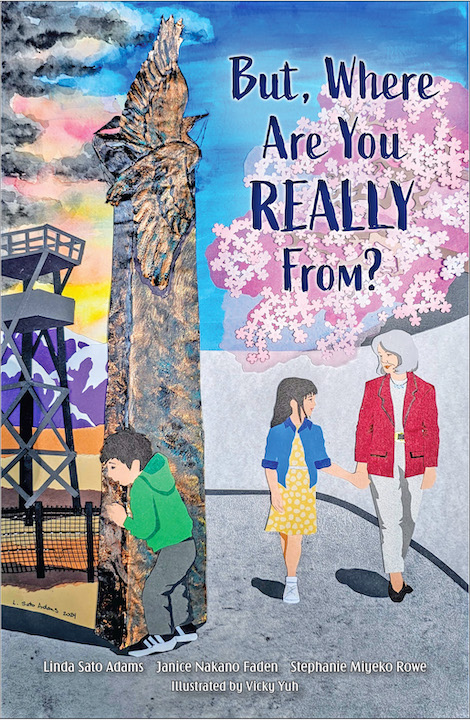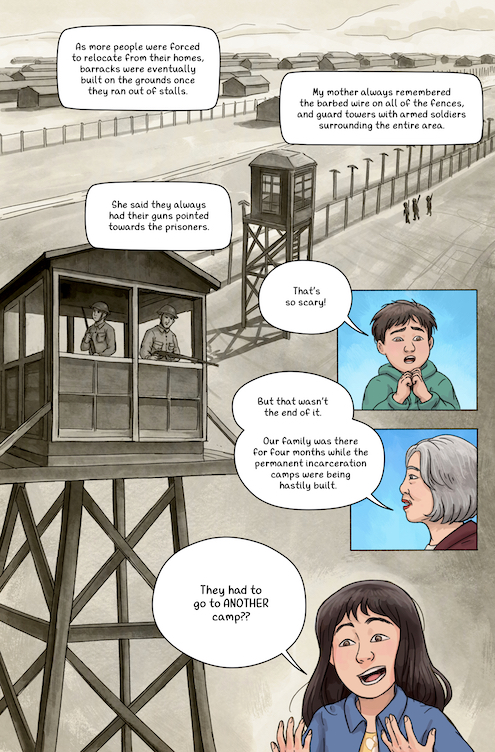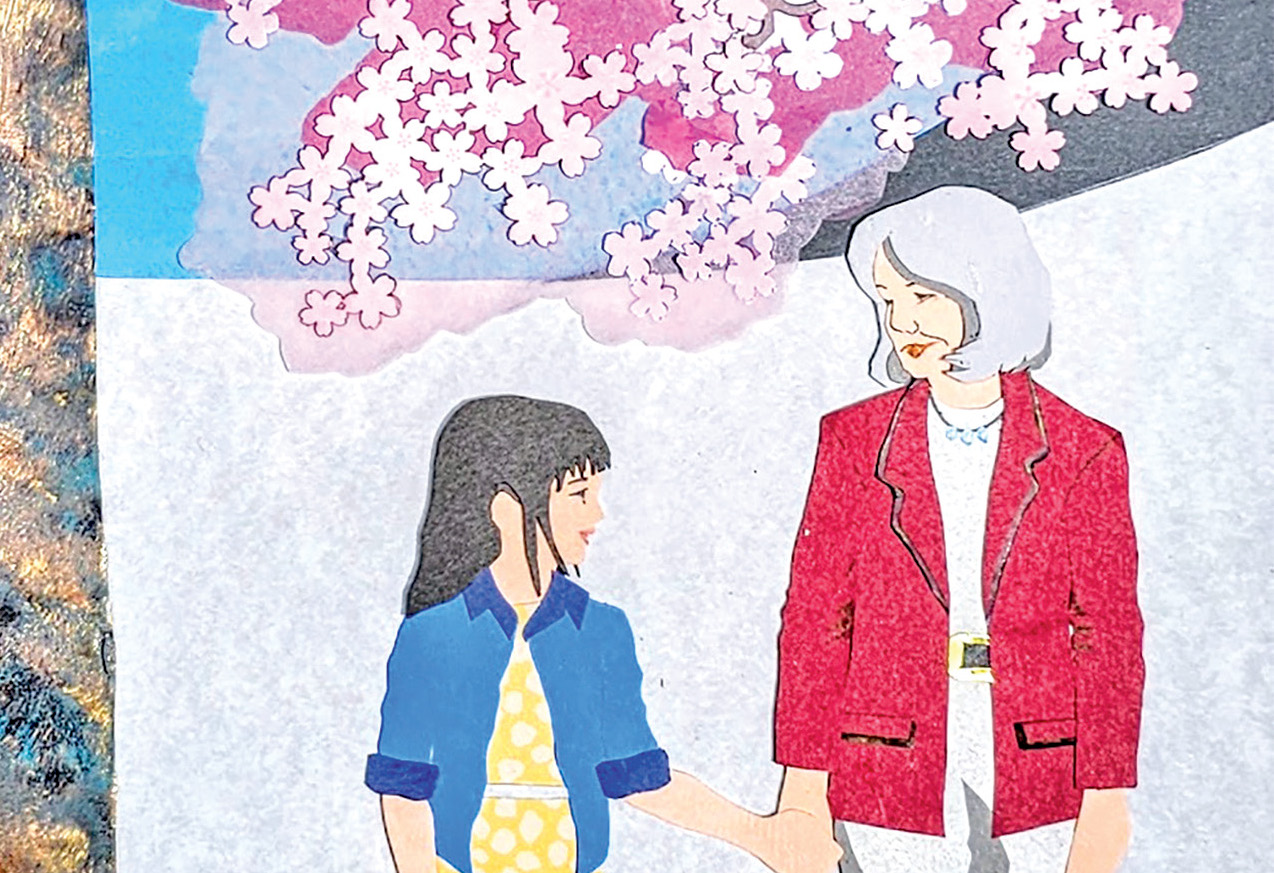Cover art from the graphic novel “But Where Are You REALLY From?,”
which was produced by the D.C. Chapter of JACL with a JACL Legacy Fund Grant.
A new graphic novel teaches
the next generation about Japanese American history.
By Gil Asakawa, P.C. Contributor

Cover art for the new graphic novel “But, Where Are You REALLY From?”
A new graphic novel aimed at fifth-graders tells the story of Japanese Americans in a novel way — a graphic novel way — that educates both young and old readers on multiple levels. The book “But, Where Are You REALLY From?” answers its titular question, variations of which most JAs have heard all their lives, with a narrative framework that students can immediately identify with and understand.
The question is the result of a class assignment from a fifth-grade art teacher who assigns his students a collage for homework, with the query, “How has my family heritage influenced who I am today and who I will become in the future?” He urges the diverse students to share their family culture, from national flags from their ancestors’ home countries to icons that evoke their cultural heritage.
Emi Kobayashi, the main character of the book, realizes that though her father’s side of the family came from Japan, she doesn’t know their history. She also realizes that she doesn’t know much about Japanese culture besides the fact that she likes sushi.
After school, Emi and her younger brother, Theo, are picked up by their Grandma May, and Emi asks the question that drives the narrative: “Grandma May . . . Where is our family REALLY from?”
With that question, the book is off and running through the JA experience of immigration and arrival, early work as laborers, facing racism, wartime incarceration and military heroism, all the way to the anti-Asian hate of the present day.
The first stop on this trip of self-discovery for Emi and Theo is a surprise drive into Washington, D.C., to the Japanese American Memorial to Patriotism During World War II, which is too often overlooked by tourists — even JA tourists — walking around the Capitol, National Monument and National Mall.
As the kids’ tour guide, May reveals the family’s immigration history and how they ended up in Maryland. She explains the hardship of the Issei generation and then the trauma of World War II and incarceration and the heroes who fought Executive Order 9066 and later, the men who fought in battle for the U.S.
Later in the book, there’s a page profiling Mitsuye Endo, the woman who fought incarceration who is often overlooked in history, even though she actually won her case, as well as pages about the resisters, JAs in the military (including Nisei women who served) and the Congressional Gold medals, the Civil Liberties Act of 1988 and more.
The graphic novel, which is stylistically like a cross between a Japanese manga and an American comic book, presents a complex, multifaceted story that addresses a handful of important social studies topics in an entertaining, easy-to-absorb format.
It’s a JA journey, but it’s also a story set against a diverse backdrop of multicultural students and an African American art teacher, getting his class to think beneath the surface about their identities and how they fit into the modern world.
The three Japanese American women behind this remarkable project are educators themselves, so they understand the power of storytelling and the impression that power can leave on young minds.
Two of the women are (or were) art teachers, which explains the central role the visual arts of the collage plays in the plot.

(From left) Kazuma Parkinson, Linda Sato Adams, Janice Nakano Faden, Kim Hirose Tobe and John Tobe at July’s JACL National Convention (Photo: Kris Ikejiri)
Linda Sato Adams was an art teacher and supervisor for fine arts for Montgomery County Public Schools in Maryland, north of Washington, D.C. Janice Nakano Faden was an elementary-level curriculum director for Montgomery County Public Schools who is an expert in making sure what is taught to students is presented in an age-appropriate way that makes sense and will be absorbed; both women are leaders in the JACL D.C. chapter. Stephanie Mieko Rowe, Adams’ niece, grew up in North Carolina but attended college in Maryland, then taught art and now is attending Florida State University to earn her graduate degree.
All three wrote the story for “But, Where Are You REALLY From?” and contributed to the rich tapestry of extra content throughout the book, from the helpful vocabulary terms (both Japanese words like “Nisei” and “origami” to helpful English words such as “alien,” “incarceration camps” and “hate crimes”) at the beginning of each chapter, as well as the pages of infographics and historical profiles (Norm Mineta, Spark Matsunaga and three JAs who the authors interviewed and included their experiences in the book: Mary Murakami, Terry Shima and Alice Takemoto) that add depth and context to Emi’s path to her collage, “The Good Stuff Is Inside,” and her powerful Artist’s Statement about what she has learned.

A page from the graphic novel “But, Where Are You REALLY From?” (Courtesy of JACL D.C. Chapter)
For Adams, Faden and Rowe, the initial idea was simple: Let’s teach young people about the Japanese American experience in a way they could easily consume — as a graphic novel!
They found a perfect partner in Vicky Yuh to illustrate the book and bring their vision to fruition. The artwork throughout is clear and easy to understand and absorb, and while the storyboards are chock-full of bright, modern colors, the re-created historical images are painted in a sepia tone that evoke the history they portray.
Every aspect of the book is intentional, according to its creators. The idea was one Adams and Faden kicked around with the JACL D.C. chapter, and through Adams’ ties to the school district’s arts program, she obtained approval for the project.
Although they had originally planned to aim the book at high school students, the district guided them to fifth-graders, who have fewer choices of courses to study, as opposed to high-schoolers, who have a plethora of topics and activities from which to choose.
The project took root when Adams and Faden discussed applying for a JACL Legacy Fund Grant through the D.C. chapter. The duo kicked around the idea, and chapter members suggested a graphic novel to appeal to young people.
“What was inspiring for Janice was that with the graphic novel, we can really reach a lot of different students, and we had known at that time that Montgomery County had just approved an Asian American Studies course in the high school,” Adams recalled. “So, felt like it was a good time to at least approach Montgomery County to see if it could be something that they would be interested in.”
Adams contacted a friend at the district. “We were thinking that this would probably be something for their high schools. And she’s like, ‘Oh, Linda, I really want to talk to you because they were going to be implementing a brand-new curriculum starting in 2024, and they really wanted this for fifth grade.”
It was an easy decision to adjust to a younger readership because if it’s part of the fifth grade curriculum, “all fifth-graders would get it. So, instead of impacting, you know, maybe 25 students in, you know, two to four schools a year, we’re talking about right now close to 11,000 students.”
The approach has already paid off. Faden says they’ve delivered 136 books to every elementary school in Montgomery County. The authors hope to be able to fund future print runs to distribute the book to school districts, libraries and museums across the country. They’re also hoping to have the book be available for purchase at the Smithsonian American History Museum’s gift shop. Additional plans include translating the book into Chinese, French and Spanish for schools aimed at Montgomery County students who speak those languages, as well as a future Japanese edition for a Japanese language school.
The book made its debut at July’s JACL National Convention in Philadelphia, where Adams and Faden drove up with a car filled with the graphic novel. Since then, they’ve made their way into Maryland schools.

Generations infographic from “But, Where Are You REALLY From?”
“When I have been out and about since the book has been available, I have seen bulletin boards filled with papers written by fifth-graders who have presented the results of their interviews with their parents and grandparents telling where they have come from in all countries around the world and how that has impacted their customs, their food, their celebrations and their understandings,” said Faden. “So, that has been great. Just the other day, a friend had left a book out on her table when she had gone with the family to a beach week. This is a grandma, and the grandson says, ‘I know that book.’” The grandson was in fourth grade at the time, so the book is reaching outside its targeted audience.”
The pair have also been asked to meet with state officials. “We’re also going to be working with the State Department of Education because they want us to present what we have done, and they want us to show it to help other jurisdictions use outside resources since some of the school districts are limited in their funds to broaden and deepen their curriculum,” said Faden.
“The book continues to live on with many, many, many legs,” she added.
The road ahead looks long but brightly lit and smoothly paved, with potential to help educate people across the country about the JA community’s long journey to today.
Rowe, from her campus in Florida, agrees. “I mean, there are so many different ideas that went into this book and so many, you know, repercussions in a positive way that some of us didn’t even expect,” she said.
Because she taught art to elementary students, Rowe feels that she understands the mind-set of that age and how art in particular can reach their consciousness.
“I took a lot from my experience of working with fifth- and sixth-graders. I mean, that was one of my favorite grades to teach because they’re just so much fun, and they’re really becoming more critical thinkers at that point,” she said. “I feel, especially like with art, that it’s a great time where you can kind of get them in and get them to like what art can offer for different lines of inquiry.”
Rowe added: “I would just say that this was really a labor of love. None of us came in here for a profit, obviously. So, to get this kind of reception just for the first printing of the book has just been amazing, honestly.”
They should brace themselves for more of the same.
To purchase “But, Where Are You REALLY From?” contact the JACL D.C. chapter at https://jacl-dc.org/.




